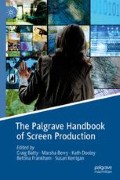Abstract
Digital production has had a transformative impact on the temporal process of traditional screen production, such that screen content is not only “fixed in post” but now also “made in post.” However, industrial ideologies and production protocols related to digital visual effects (VFX) and post-production tacitly maintain distinctions between creative and technical skillsets and labour output across production stages, particularly between principal and post-production. This chapter focuses on the production culture concerning digital VFX, which productively reflects the complex temporal dynamics impacting the value of creativity in post-production more broadly. The production protocol “fix it in post” reflects a history of such ideologies that marginalise and devalue the contribution of post-production in the creative appraisal of screen output; moreover, the protocol expresses creative value in temporal terms, in which “after-ness” in the screen production process connotes technical activity of less creative value. Similarly, the distinction between special effects (SFX) and VFX terminology reinforces temporal boundaries between principal and post-production in the screen production workflow. As such, this chapter argues that the devaluing of creative activity in post-production is an ideological imperative driven by the temporal categorisation of “after-ness,” which implies a deferment, marginalisation, and decentralisation of creative value in the screen production process.
Access this chapter
Tax calculation will be finalised at checkout
Purchases are for personal use only
References
Belton, J. (2012). Painting by the Numbers: The Digital Intermediate. Film Quarterly, 61(3), 58–65.
Boden, M. A. (2004). The Creative Mind: Myths and Mechanisms. London: Routledge.
Caldwell, J. T. (2008). Production Culture: Industrial Reflexivity and Critical Practice in Film and Television. Durham: Duke University Press.
Case, D. (2001). Film Technology in Post Production. New York: Focal Press.
Cram, C. (2012). Digital Cinema: The Role of the Visual Effects Supervisor. Film History, 24, 169–186.
Daigle, A. (2015). (Post)Production: Classifications and Infrastructures of Digital Visual Effects. Critical Studies in Media Communication, 32(3), 161–176.
Dinur, E. (2017). The Filmmaker’s Guide to Visual Effects: The Art and Techniques of VFX for Directors, Producers, Editors, and Cinematographers. New York: Routledge.
Finance, C. L., & Zwerman, S. (2010). The Visual Effects Producer: Understanding the Art and Business of VFX. Boston: Focal Press.
Fink, M., & Morie, J. F. (2010). Introduction. In J. A. Okun & S. Zwerman (Eds.), The VES Handbook of Visual Effect: Industry Standard VFX Practices and Procedures (pp. 1–15). Burlington: Focal Press.
Gaut, B., & Kieran, M. (Eds.). (2018). Creativity and Philosophy. Oxon: Routledge.
Glăveanu, V. P. (2016). Introducing Creativity and Culture, the Emerging Field. In V. P. Glăveanu (Ed.), The Palgrave Handbook of Creativity and Culture Research (pp. 1–12). London: Palgrave Macmillan.
Goulekas, K. E. (Ed.). (2001). Visual Effects in a Digital World: A Comprehensive Glossary of Over 7000 Visual Effects Terms. Burlington: Morgan Kaufmann.
Greenhalgh, C. (2017). Cinematography: Practice as Research, Research into Practice. In C. Batty & S. Kerrigan (Eds.), Screen Practice Research: Creative Practice as a Mode of Enquiry (pp. 143–159). New York: Palgrave Macmillan.
Hayes, R. M. (1986). Trick Cinematography: The Oscar Special-Effects Movies. Jefferson: McFarland.
Kaufman, D. (2003). A Flexible Finish. American Cinematographer, 84(4), Retrieved from https://theasc.com/magazine/april03/sub/index.html
Kaufman, D. (2009, July 1). DP Dante Spinotti on Public Enemies. Studio Daily. Retrieved from http://www.studiodaily.com/2009/07/dpa‚a-dante-spinotti-on-public-enemies/
Kaufman, D. (2018, January 2). VFX Screen Credits: The Quest for Recognition and Respect. VFX Voice: The Magazine of the Visual Effects Society. Retrieved from http://vfxvoice.com/vfx-screen-credits-the-quest-for-recognition-and-respect/
Mason, J. H. (2003). The Value of Creativity: The Origin and Emergence of a Modern Belief. New York: Routledge.
Mayer, V., Banks, M. J., & Caldwell, J. T. (2009). Production Studies: Roots and Routes. In V. Mayer, M. J. Banks, & J. T. Caldwell (Eds.), Production Studies: Cultural Studies of the Media Industries (pp. 1–12). New York: Routledge.
McAlister, M. J. (1993). The Language of Visual Effects. Los Angeles: Lone Eagle Publishing.
McIntyre, P. (2012). Creativity and Cultural Production: Issues for Media Practice. London: Palgrave Macmillan.
Navas, E. (2018). Art, Media Design, and Postproduction: Open Guidelines on Appropriation and Remix. New York: Routledge.
Negus, N., & Pickering, M. (2004). Creativity, Communication and Cultural Value. London: Sage Publications.
Prince, S. (2012). Digital Visual Effects in Cinema: The Seduction of Reality. New Brunswick: Rutgers University Press.
Stahl, M. (2009). Privilege and Distinction in Production Worlds: Copyright, Collective Bargaining, and Working Conditions in Media Making. In V. Mayer, M. J. Banks, & J. T. Caldwell (Eds.), Production Studies: Cultural Studies of the Media Industries (pp. 54–67). New York: Routledge.
Uricchio, W. (2014). Film, Cinema, Television … Media? New Review of Film and Television Studies, 12(3), 266–279.
Vaziri, T. [tvaziri]. (2018, July 3). Visual Effects Are Created by People, Not Computers [Tweet]. Retrieved from https://twitter.com/tvaziri/status/1013818417600581633
Wyatt, H., & Amyes, T. (2005). Audio Post Production for Television and Film: An Introduction to Technology and Techniques. Oxford: Focal Press.
Author information
Authors and Affiliations
Corresponding author
Editor information
Editors and Affiliations
Rights and permissions
Copyright information
© 2019 The Author(s)
About this chapter
Cite this chapter
Lomax, T. (2019). “Make it in Post”: Digital Visual Effects and the Temporality of Creative Value in Post-Production. In: Batty, C., Berry, M., Dooley, K., Frankham, B., Kerrigan, S. (eds) The Palgrave Handbook of Screen Production. Palgrave Macmillan, Cham. https://doi.org/10.1007/978-3-030-21744-0_21
Download citation
DOI: https://doi.org/10.1007/978-3-030-21744-0_21
Published:
Publisher Name: Palgrave Macmillan, Cham
Print ISBN: 978-3-030-21743-3
Online ISBN: 978-3-030-21744-0
eBook Packages: Literature, Cultural and Media StudiesLiterature, Cultural and Media Studies (R0)

